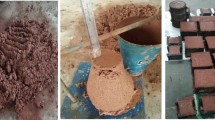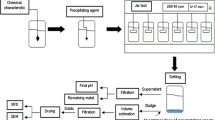Abstract
Solidification and stabilization are well-known technologies used for treating hazardous waste. These technologies that use cementitious binder have been applied for decades as a final treatment procedure prior to the hazardous waste disposal. In the present work, hazardous waste like fly ash containing high concentrations of heavy metals such Zn (4715.56 mg/kg), Pb (1300.56 mg/kg), and Cu (534.72 mg/kg) and amounts of Ag, Cd, Co, Cr, Mn, and Ni was sampled from a city refuse incinerator facility. This fly ash was utilized in the solidification/stabilization of heavy metal sludge since fly ash has cement-like characteristics. Cement additives such as sodium sulfate, sodium carbonate, and ethylenediaminetetraacetic acid (EDTA) was incorporated to the solidified matrix in order to determine its effect on the solidification/stabilization performance. The solidified matrix was cured for 7, 14, 21, and 28 days prior for its physical and chemical characterizations. The results show that the solidified matrix containing 40% fly ash and 60% cement with heavy metal sludge was the formulation that has the highest fly ash content with a satisfactory strength. The solidified matrix was also able to immobilize the heavy metals both found in the fly ash and sludge based on the toxicity characteristic leaching procedure (TCLP) test. It also shows that the incorporation of sodium carbonate into the solidified matrix not only further improved the compressive strength from 0.36 MPa (without Na2CO3) to 0.54 MPa (with Na2CO3) but also increased its leaching resistance.





Similar content being viewed by others
References
Barth E, Percin P, Arozarena M, Zieleinswski J, Dosani M, Maxey S, Hokanson C, Pryately TW, Kravitz R, Cullinane M, Jones L, Malone P (1989) Malone, stabilization and solidification of hazardous wastes. Noyes Data Corporation, New Jersey
Bayuseno AP, Schmahl WW (2011) Characterization of MSWI fly ash through mineralogy and water extraction. Resour Conserv Recycl 55:524–534
Bernal S, Provis J, Myers R, Nicolas R, van Deventer J (2015) Role of carbonates in the chemical evolution of sodium carbonate-1 activated slag binders. Mater Struct 48:517–529
Chang F-Y, Wey M-Y (2006) Comparison of the characteristics of bottom and fly ashes generated from various incineration processes. J Hazard Mater 138:594–603
Cioffi R, Colangelo F, Montagnaro F, Santoro L (2011) Manufacture of artificial aggregate using MSWI bottom ash. Waste Manag 31:281–288
Colangelo F, Cioffi R, Montagnaro F, Santoro L (2012) Soluble salt removal from MSWI fly ash and its stabilization for safer disposal and recovery as road basement material. Waste Manag 32:1179–1185
Diaz E, Allouche E, Eklund S (2010) Factors affecting the suitability of fly ash as source material for geopolymers. Fuel 89:992–996
Diaz-Loya EI, Allouche EN, Eklund S, Joshi AR, Kupwade-Patil K (2012) Toxicity mitigation and solidification of municipal solid waste incinerator fly ash using alkaline activated coal ash. Waste Manag 32:1521–1527
Fedje KK, Ekberg C, Skarnemark G, Steenari B-M (2010) Removal of hazardous metals from MSW fly ash—an evaluation of ash leaching methods. J Hazard Mater 173:310–317
Ferone C, Colangelo F, Messina F, Santoro L, Cioffi R (2013) Recycling of pre-washed municipal solid waste incinerator fly ash in the manufacturing of low temperature setting geopolymer materials. Materials 6:3420–3437
Hills CD, Pollard SJ (1997) The influence of interference effects on the mechanical, microstructural and fixation characteristics of cement-solidified hazardous waste forms. J Hazard Mater 52:171–191
Hu Y, Zhang P, Chen D, Zhou B, Li J, Li XW (2012) Hydrothermal treatment of municipal solid waste incineration fly ash for dioxin decomposition. J Hazard Mater 207-208:79–85
Hu HY, Liu H, Shen WQ, Luo GQ, Li AJ, Lu ZL, Yao H (2013) Comparison of CaO’s effect on the fate of heavy metals during thermal treatment of two typical types of MSWI fly ashes in China. Chemosphere 93:590–596
Kaniraj SR, Havanagi VG (1999) Compressive strength of cement stabilized fly ash-soil mixtures. Cement Concrete Res 29:673–677
Lancellotti I, Kamseu E, Michelazzi M, Barbieri L, Corradi A, Leonelli C (2010) Chemical stability of geopolymers containing municipal solid waste incinerator fly ash. Waste Manag 30:673–679
Li M, Xiang J, Hu S, Sun L-S, Su S, Li P-S, Sun X-X (2004) Characterization of solid residues from municipal solid waste incinerator. Fuel 83:1397–1405
Malviya R, Chaudhary R (2004) Study of the treatment effectiveness of a solidification/stabilization process for waste bearing heavy metals. J Mater Cycles Waste Manag 6:147–152
Mayers T, Eappi M (1992) Laboratory evaluation of stabilization/solidification technology for reducing the mobility of heavy metals in New Bedford Harbor superfund site sediment, stabilization of hazardous radioactive and mixed wastes. ASTM Publication, Philadelphia, p. 304
Nowak B, Frías Rocha S, Aschenbrenner P, Rechberger H, Winter F (2012) Heavy metal removal from MSW fly ash by means of chlorination and thermal treatment: influence of the chloride type. Chem Eng J 179:178–185
Okada T, Tomikawa H (2013) Effects of chemical composition of fly ash on efficiency of metal separation in ash-melting of municipal solid waste. Waste Manag 33:605–614
Qian G, Cao Y, Chui P, Tay J (2006) Utilization of MSWI fly ash for stabilization/solidification of industrial waste sludge. J Hazard Mater 129:274–281
Roy A, Cartledge FK (1997) Long-term behavior of a Portland cement-electroplating sludge waste form in presence of copper nitrate. J Hazard Mater 52:265–286
Roy A, Eaton HC, Cartledge FK, Tittlebaum ME (1992) Solidification/stabilization of hazardous waste: evidence of physical encapsulation. Environ Sci Technol 26:1349–1353
Su Y, Yang J, Liu D, Zhen S, Lin N, Zhou Y (2016) Effects of municipal solid waste incineration fly ash on solidification/stabilization of Cd and Pb by magnesium potassium phosphate cement. J Environ Chem Eng 4:259–265
Sun Y, Watanabe N, Qiao W, Gao X, Wang W, Zhu T (2010) Polysulfide as a novel chemical agent to solidify/stabilize lead in fly ash from municipal solid waste incineration. Chemosphere 81:120–126
Sun Y, Zheng J, Zou L, Liu Q, Zhu P, Qian G (2011) Reducing volatilization of heavy metals in phosphate-pretreated municipal solid waste incineration fly ash by forming pyromorphite-like minerals. Waste Manag 31:325–330
SW-846 test method 1311: toxicity characteristic leaching procedure. https://www.epa.gov/hw-sw846/sw-846-test-method-1311-toxicity-characteristic-leaching-procedure. Accessed 30 Aug 2016
Swarnalatha S, Ganesh Kumar A, Tandaiah S, Sekaran G (2009) Efficient and safe disposal of chrome shavings discharged from leather industry using thermal combustion. J Chem Technol Biot 84:751–760
Sweeney R, Hills C, Buenfeld N (1998) Investigation into the carbonation of stabilised/solidified synthetic waste. Environ Technol 19:893–902
Wang F-H, Zhang F, Chen Y-J, Gao J, Zhao B (2015) A comparative study on the heavy metal solidification/stabilization performance of four chemical solidifying agents in municipal solid waste incineration fly ash. J Hazard Mater 300:451–458
Youcai Z, Lijie S, Guojian L (2002) Chemical stabilization of MSW incinerator fly ashes. J Hazard Mater 95:47–63
Zou D, Chi Y, Fu C, Dong J, Wang F, Ni M (2013) Co-destruction of organic pollutants in municipal solid waste leachate and dioxins in fly ash under supercritical water using H2O2 as oxidant. J Hazard Mater 248-249:177–184
Acknowledgments
The authors would like to thank the Ministry of Science and Technology, Taiwan for financially supporting this research under Contract No. NSC 102-2221-E-041-001-MY3.
Author information
Authors and Affiliations
Corresponding author
Additional information
Responsible editor: Philippe Garrigues
Rights and permissions
About this article
Cite this article
Cerbo, A.A.V., Ballesteros, F., Chen, T.C. et al. Solidification/stabilization of fly ash from city refuse incinerator facility and heavy metal sludge with cement additives. Environ Sci Pollut Res 24, 1748–1756 (2017). https://doi.org/10.1007/s11356-016-7943-z
Received:
Accepted:
Published:
Issue Date:
DOI: https://doi.org/10.1007/s11356-016-7943-z




